Spatial Connectivity and Development Potential of Traditional Villages in Clustered Areas: A Case Study of Qiandongnan Prefecture
Abstract
1. Introduction
2. Methodology
2.1. Case Study Area
2.2. Research Methods
2.2.1. Spatial Layout Analysis Method
- (1)
- Kernel Density Analysis Method
- (2)
- Nearest Neighbor Index
- (3)
- Imbalance Index
2.2.2. Spatial Relationship Analysis
Social Network Analysis Method
- (1)
- Stability
- (2)
- Vulnerability
- (3)
- Balance
- (4)
- Point Degree Centrality
Spatial Relationship Visualization Analysis Method
2.2.3. Method for Constructing Evaluation Systems
2.3. Data Sources and Calculation
3. Results
3.1. Spatial Distribution Characteristics of Traditional Villages in Qiandongnan
3.1.1. The Spatial Pattern Distribution Characteristics of Traditional Villages in Qiandongnan
3.1.2. Characteristics of the Spatial Distribution of Traditional Villages in Qiandongnan
3.2. Characteristics of Spatial Connectivity in Traditional Villages of Qiandongnan
3.2.1. The Spatial Network Relationships of Traditional Villages in Qiandongnan
3.2.2. Spatial Connectivity Relationships of Traditional Villages in Qiandongnan
- (1)
- Stability Analysis of Spatial Connectivity Relationships
- (2)
- Vulnerability Analysis of Spatial Connectivity Relationships
- (3)
- Balance Analysis of Spatial Connectivity Relationships
3.3. Analysis of the Development Potential and Strategies for Traditional Villages in Qiandongnan
3.3.1. Construction of an Evaluation Model for the Development Potential of Traditional Villages in Qiandongnan
3.3.2. Lambda Collection in Different Periods
3.3.3. Development Strategies for Traditional Villages in Qiandongnan
- (1)
- Overall Protection and Development Strategy for Traditional Villages in Qiandongnan
- (2)
- Strategies for the Individual Protection and Development of Traditional Villages in Qiandongnan
4. Discussion
5. Conclusions
Author Contributions
Funding
Data Availability Statement
Acknowledgments
Conflicts of Interest
References
- Chung, H.; Lee, J. Modern Industrial Heritage as Cultural Mediation in Urban Regeneration: A Case Study of Gunsan, Korea, and Taipei, Taiwan. Land 2023, 12, 792. [Google Scholar] [CrossRef]
- Wang, H.-f.; Chiou, S.-c. Study on the Sustainable Development of Human Settlement Space Environment in Traditional Villages. Sustainability 2019, 11, 4186. [Google Scholar] [CrossRef]
- Wu, C.; Chen, M.; Zhou, L.; Liang, X.; Wang, W. Identifying the Spatiotemporal Patterns of Traditional Villages in China: A Multiscale Perspective. Land 2020, 9, 449. [Google Scholar] [CrossRef]
- Zhao, W.; Xiao, D.; Li, J.; Xu, Z.; Tao, J. Research on Traditional Village Spatial Differentiation from the Perspective of Cultural Routes: A Case Study of 338 Villages in the Miao Frontier Corridor. Sustainability 2024, 16, 5298. [Google Scholar] [CrossRef]
- Ma, H.; Tong, Y. Spatial differentiation of traditional villages using ArcGIS and GeoDa: A case study of Southwest China. Ecol. Inf. 2022, 68, 101416. [Google Scholar] [CrossRef]
- Liu, S.; Ge, J.; Bai, M.; Yao, M.; He, L.; Chen, M. Toward classification-based sustainable revitalization: Assessing the vitality of traditional villages. Land Use Policy 2022, 116, 106060. [Google Scholar] [CrossRef]
- Xu, K.; Qian, X.; Wen, Q. Stewardship of built vernacular heritage for local development: A field research in southwestern villages of China. Habitat Int. 2022, 129, 102665. [Google Scholar] [CrossRef]
- Chen, X.; Xie, W.; Li, H. The spatial evolution process, characteristics and driving factors of traditional villages from the perspective of the cultural ecosystem: A case study of Chengkan Village. Habitat Int. 2020, 104, 102250. [Google Scholar] [CrossRef]
- Hu, Z.; Strobl, J.; Min, Q.; Tan, M.; Chen, F. Visualizing the cultural landscape gene of traditional settlements in China: A semiotic perspective. Herit. Sci. 2021, 9, 115. [Google Scholar] [CrossRef]
- Xu, Q.; Wang, J. Recognition of Values of Traditional Villages in Southwest China for Sustainable Development: A Case Study of Liufang Village. Sustainability 2021, 13, 7569. [Google Scholar] [CrossRef]
- Li, M.; Yan, Y.; Ying, Z.; Zhou, L. Measuring Villagers’ Perceptions of Changes in the Landscape Values of Traditional Villages. ISPRS Int. J. Geo-Inf. 2024, 13, 60. [Google Scholar] [CrossRef]
- Fu, J.; Zhou, J.; Deng, Y. Heritage values of ancient vernacular residences in traditional villages in Western Hunan, China: Spatial patterns and influencing factors. Build. Environ. 2021, 188, 107473. [Google Scholar] [CrossRef]
- Su, H.; Wang, Y.; Zhang, Z.; Dong, W. Characteristics and Influencing Factors of Traditional Village Distribution in China. Land 2022, 11, 1631. [Google Scholar] [CrossRef]
- Chen, W.; Yang, L.; Wu, J.; Wang, G.; Bian, J.; Zeng, J.; Liu, Z. Spatio-temporal characteristics and influencing factors of traditional villages in the Yangtze River Basin: A Geodetector model. Herit. Sci. 2023, 11, 111. [Google Scholar] [CrossRef]
- Liu, C.; Xu, M. Characteristics and Influencing Factors on the Hollowing of Traditional Villages—Taking 2645 Villages from the Chinese Traditional Village Catalogue (Batch 5) as an Example. Int. J. Environ. Res. Public Health 2021, 18, 12759. [Google Scholar] [CrossRef] [PubMed]
- Gao, J.; Wu, B. Revitalizing traditional villages through rural tourism: A case study of Yuanjia Village, Shaanxi Province, China. Tour. Manag. 2017, 63, 223–233. [Google Scholar] [CrossRef]
- Zhang, J.; Zhang, R.; Li, Q.; Zhang, X.; He, X. Spatial Sifferentiation and Differentiated Development Paths of Traditional Villages in Yunnan Province. Land 2023, 12, 1663. [Google Scholar] [CrossRef]
- Liu, X.; Yuan, L.; Tan, G. Identification and Hierarchy of Traditional Village Characteristics Based on Concentrated Contiguous Development—Taking 206 Traditional Villages in Hubei Province as an Example. Land 2023, 12, 471. [Google Scholar] [CrossRef]
- Shi, B.; Liu, H.; Huang, L.; Zhang, Y.; Xiang, Z. Increasing Vulnerability of Village Heritage: Evidence from 123 Villages in Aba Prefecture, Sichuan, China. Land 2023, 12, 2048. [Google Scholar] [CrossRef]
- Şahin Körmeçli, P. Understanding the Historic Center by Using Network Analysis with Mental Mapping Method: The Case Study of Amasra, Turkey. Sustainability 2024, 16, 5387. [Google Scholar] [CrossRef]
- Zhao, L.; Li, Y.; Zhang, N.; Zhang, Z. Public policies and conservation plans of historic urban landscapes under the sustainable heritage tourism milieu: Discussions on the equilibrium model on Kulangsu Island, UNESCO World Heritage site. Built Herit. 2023, 7, 6. [Google Scholar] [CrossRef]
- Śladowski, G.; Szewczyk, B.; Barnaś, K.; Kania, O.; Barnaś, J. The Boyen Fortress: Structural analysis of selecting complementary forms of use for a proposed adaptive reuse project. Herit. Sci. 2021, 9, 76. [Google Scholar] [CrossRef]
- Wierczynska, K.; Jakubowski, A. Individual responsibility for deliberate destruction of cultural heritage: Contextualizing the ICC judgment in the Al-Mahdi case. Chin. J. Int. Law 2017, 16, 695–721. [Google Scholar] [CrossRef]
- Chang, Q. Evolution of Peak Palace-Fortress in Tibet: The Reappearance of the Sangzhutse Palace-Fortress and Design of the Fortress Museum. Built Herit. 2017, 1, 36–49. [Google Scholar] [CrossRef]
- Tavares, D.S.; Alves, F.B.; Vásquez, I.B. The Relationship between Intangible Cultural Heritage and Urban Resilience: A Systematic Literature Review. Sustainability 2021, 13, 12921. [Google Scholar] [CrossRef]
- Ginzarly, M.; Pereira Roders, A.; Teller, J. Mapping historic urban landscape values through social media. J. Cult. Herit. 2019, 36, 1–11. [Google Scholar] [CrossRef]
- Shen, C.; Lu, Q.; Chen, Q.; Zhang, M. Spatial identification and planning strategy of traditional village cluster areas: A case study of mountainous and hilly regions in Zhejiang province. Geogr. Res. 2024, 43, 446–461. [Google Scholar]
- Qiandongnan Prefecture Bureau of Statistics. Statistical Communiqué on National Economic and Social Development of Qiandongnan Prefecture in 2020. 2021. Available online: http://www.etmoc.com/eWebEditor/2022/20220611010339643.pdf (accessed on 11 September 2025).
- Cai, P. Cultural Preservation and Educational Inheritance of Traditional Villages in Southeast Guizhou; Intellectual Property Publishing House: Beijing, China, 2022. [Google Scholar]
- Li, D.; Wang, W.; Zhang, Y.; Chen, S.Y.; Li, H.; Zhu, Q.W. Temporal and Spatial Evolution and Influencing Factors of National Cultural Relics Protection Units in the Yellow River Basin. Areal Res. Dev. 2023, 42, 173–180. [Google Scholar] [CrossRef]
- Chen, Y.; Li, R. Spatial Distribution and Type Division of Traditional Villages in Zhejiang Province. Sustainability 2024, 16, 5262. [Google Scholar] [CrossRef]
- Zhang, Z.; Cui, Z.; Fan, T.; Ruan, S.; Wu, J. Spatial Distribution of Intangible Cultural Heritage Resources in China and Its Influencing Factors. Sci. Rep. 2024, 14, 4960. [Google Scholar] [CrossRef]
- Fang, X.; Tai, P.; Jiang, F. Study on the Spatial Layout and Influencing Factors of Campsites in the Yellow River Basin. Sustainability 2024, 16, 4944. [Google Scholar] [CrossRef]
- Liu, J. Analysis of the Entire Network; Shanghai People’s Publishing House: Shanghai, China, 2014. [Google Scholar]
- Sun, X.; Si, S. Complex Network Algorithm and Application; National Defense Industry Press: Beijing, China, 2015. [Google Scholar]
- Liu, A.L.; Ming, Q.Z.; Yang, C.Y.; Tan, S. Spatial Distribution Characteristics of Traditional Villages in Yunnan, Guizhou and Guizhou and Its Relationship with Tourism Development. China Agric. Resour. Reg. Plan. 2021; in press. [Google Scholar] [CrossRef]
- Yiannakou, A.; Eppas, D.; Zeka, D. Spatial Interactions between the Settlement Network, Natural Landscape and Zones of Economic Activities: A Case Study in a Greek Region. Sustainability 2017, 9, 1715. [Google Scholar] [CrossRef]
- Salles, T.; Rey, P.; Bertuzzo, E. Mapping landscape connectivity as a driver of species richness under tectonic and climatic forcing. Earth Surf. Dyn. 2019, 7, 895–910. [Google Scholar] [CrossRef]
- Yuan, X. Network Relationship and Spatial Network Characteristics of “Ecological-Living-Living-Living” Traditional Villages in Miaodong Traditional Villages in Southeast Guizhou Province. Master’s Thesis, Guizhou University, Guiyang, China, 2022. [Google Scholar]
- Zhang, B.; Fan, J.; Zhang, P.; Sha, S.; Ren, Y. The Changsha historic urban area: A study on the evolution characteristics and influencing factors of the connectivity of construction land. Herit. Sci. 2024, 12, 287. [Google Scholar] [CrossRef]
- Elzomor, M.; Parrish, K. Investigating Building Construction Process and Developing a Performance Index. Procedia Eng. 2016, 145, 211–218. [Google Scholar] [CrossRef]
- Lin, J. Research on village planning and rural architectural design based on discrete dynamic modeling technology. Sci. Program. 2022, 2022, 9031664. [Google Scholar] [CrossRef]
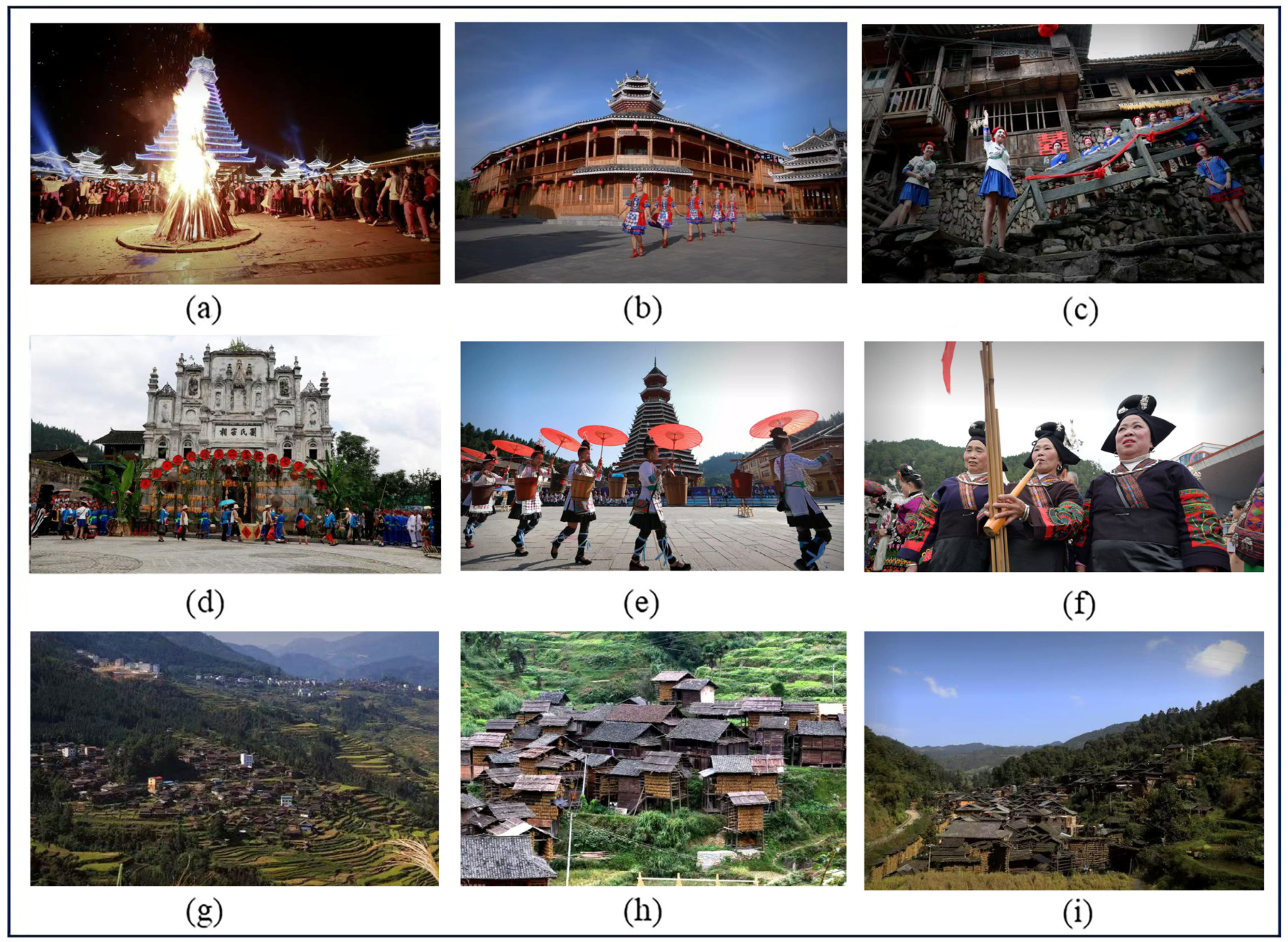
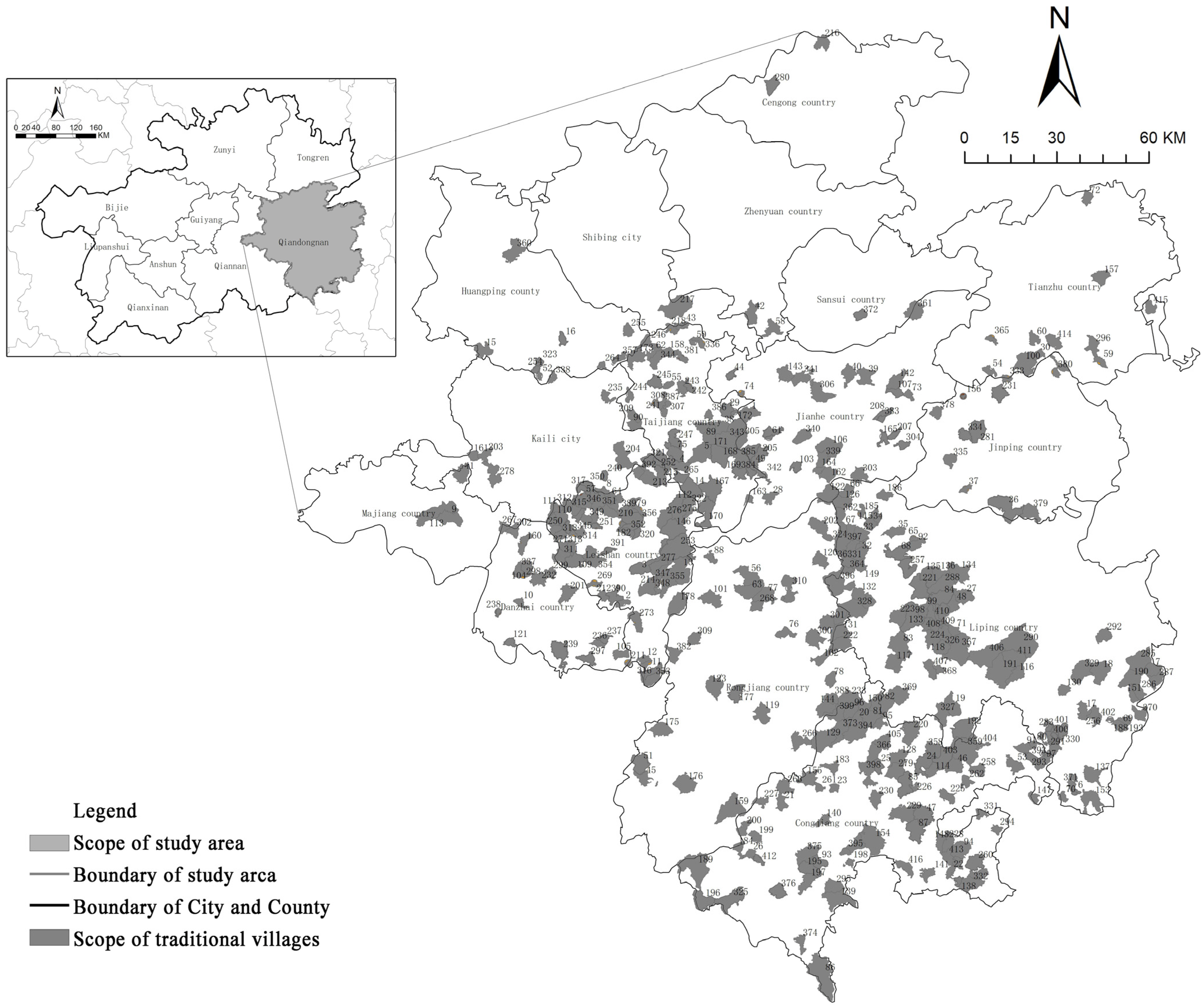
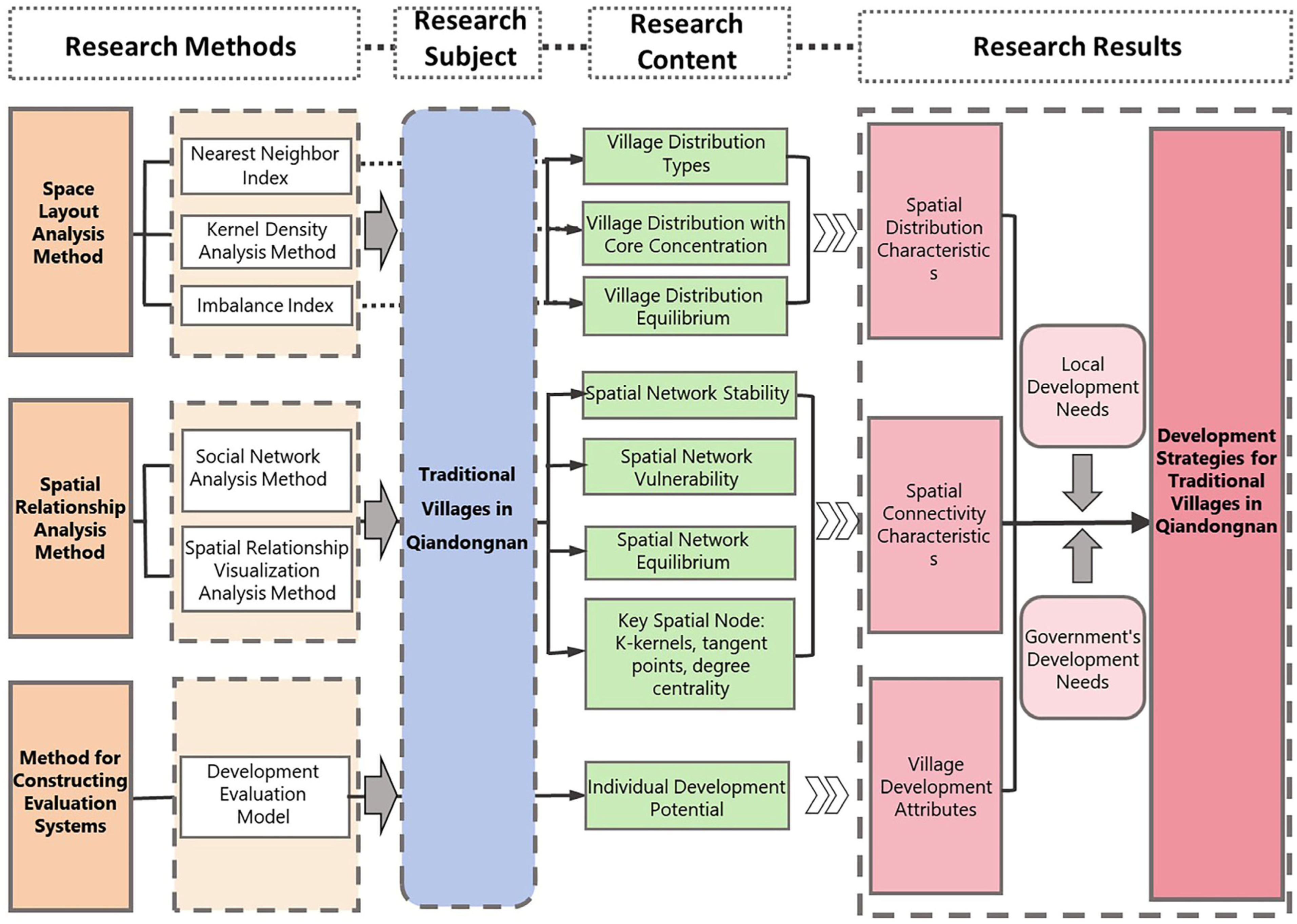
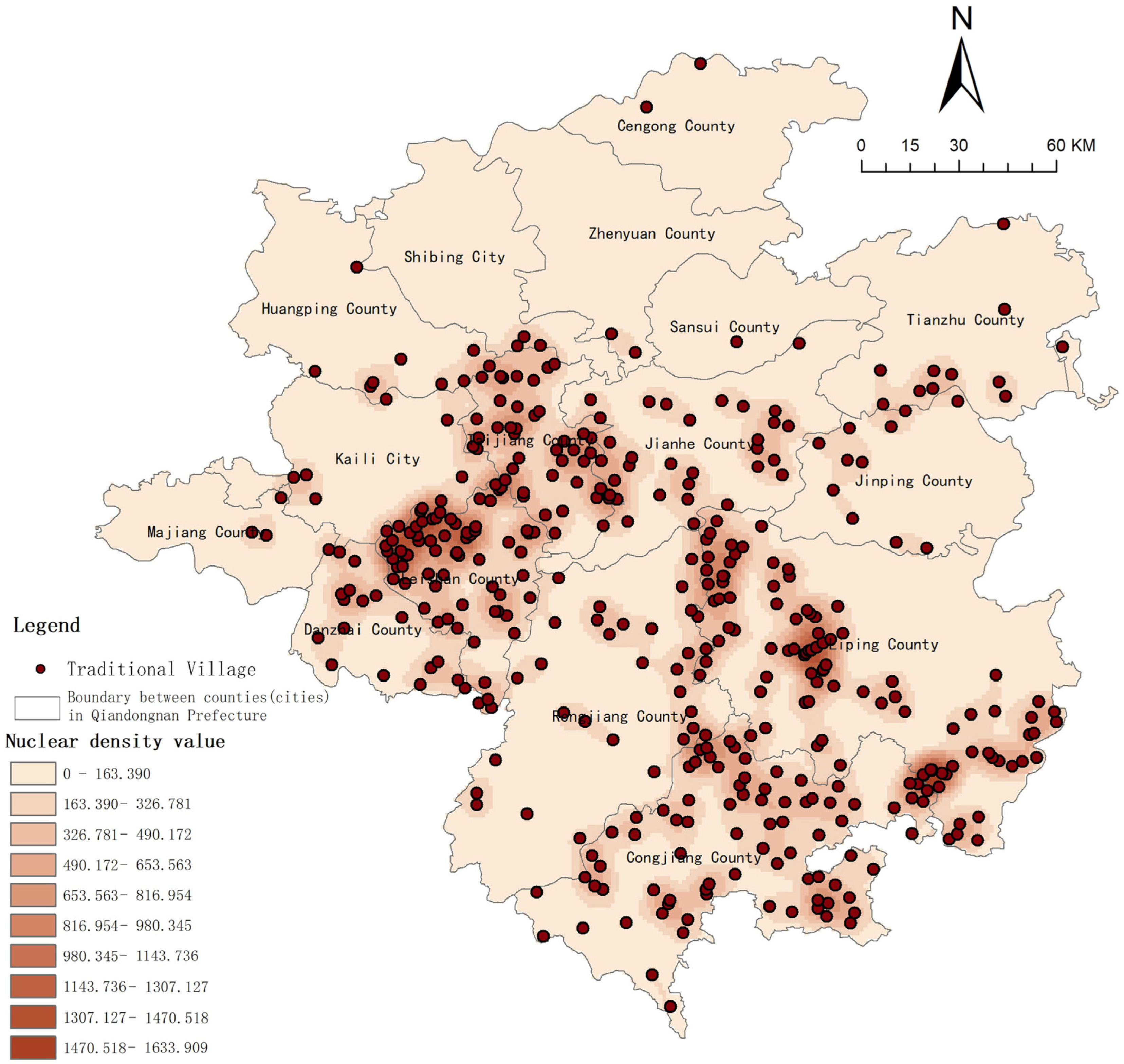

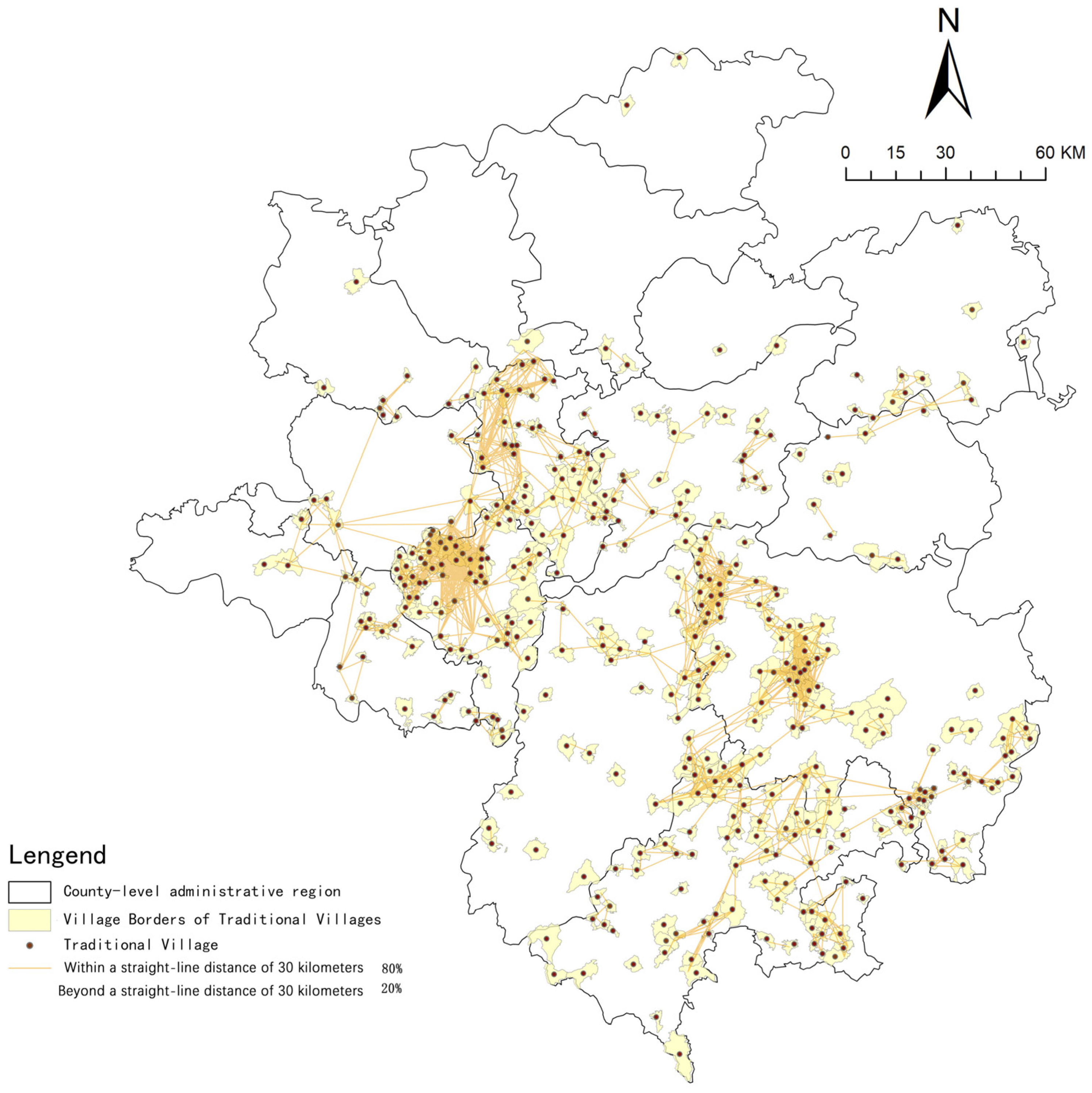
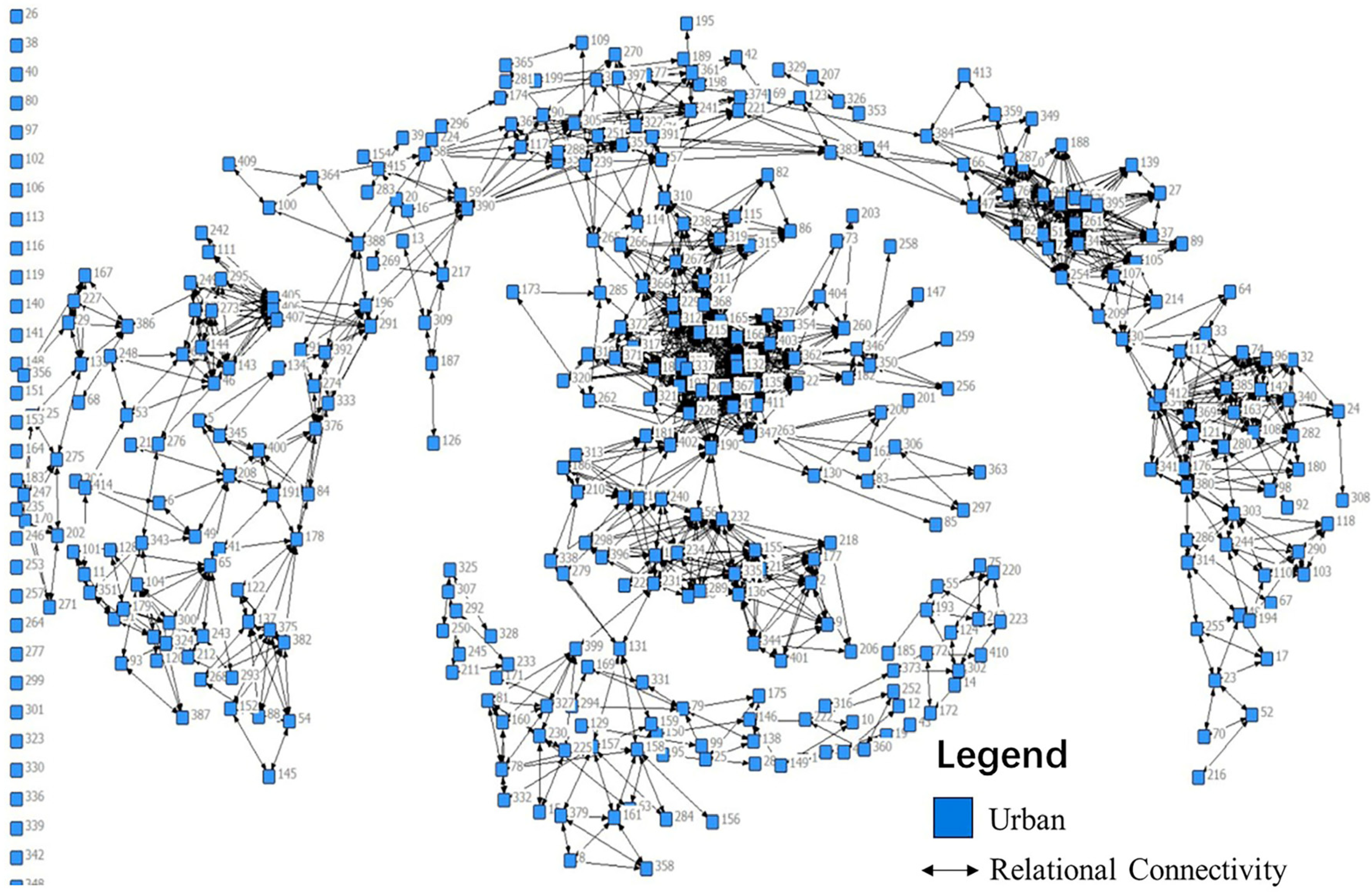

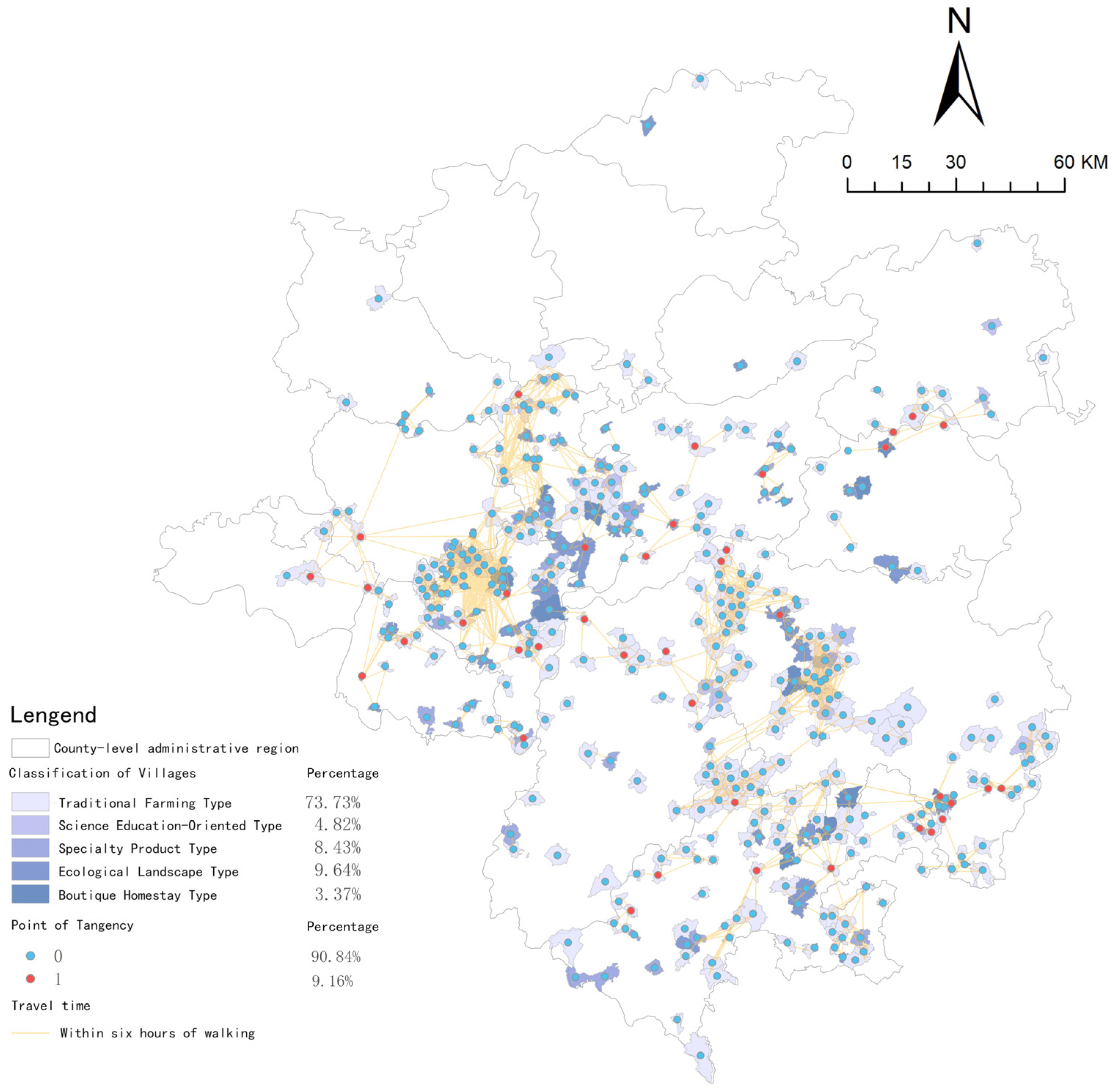


| The Name of Factory | The Geographic Concentration Index | The Nearest Neighbor Index |
|---|---|---|
| Qiandongnan Prefecture | 38.28 | 0.84 |
| Cengong County | 70.71 | 1.18 |
| Congjiang County | 25.21 | 1.22 |
| Danzhai Couty | 43.62 | 1.15 |
| Huangping County | 55.90 | 1.16 |
| Jianhe County | 32.32 | 1.13 |
| Jinping County | 35.21 | 1.12 |
| Kaili City | 50.00 | 0.97 |
| Leishan County | 35.54 | 1.04 |
| Liping County | 27.76 | 0.75 |
| Majiang County | 74.54 | 0.62 |
| Rongjiang County | 30.26 | 1.15 |
| Sansui County | 100.00 | - |
| Shibing County | 100.00 | - |
| Taijiang County | 38.55 | 1.07 |
| Tianzhu County | 47.24 | 1.18 |
| Zhenyuan County | 70.71 | 0.46 |
| Type of Development | Elements of Classification | Quantity | Characteristics of Spatial Distribution | Typical Area | Driving Factors |
|---|---|---|---|---|---|
| Agriculture + Development | Agricultural development plays the leading role, while developing the agriculture + tourism model, adding traditional farming demonstration, and characteristics of mountain high-efficiency agriculture as the main development direction. | 305 | High geographical concentration index (50–100), high proximity point index (greater than 1.15) | Sansui County, Cengong County | The valley plain has fertile land and convenient irrigation; the developed transportation network facilitates agricultural intensification. |
| Craft + Experience | With processing industry + experience tourism as the main development mode, inheriting traditional handicrafts or processing technology, and experience-led traditional handicraft production inheritance and specialty agricultural products processing. | 36 | Moderate geographic concentration index (30–50), high proximity (1.15–1.22) | Danzhai County, Congjiang County | The core areas of ethnic culture, such as the Miao and Dong inhabited regions, serve as transportation hubs that facilitate visitor access and the circulation of raw materials. |
| Eco + Landscape | It is a traditional village with ecological + landscape tourism as the main mode of development, relying on the advantages of ecological environment and natural landscape, and led by ecological tourism and leisure vacation | 40 | Low geographic concentration index (<30), moderate proximity (1.0–1.2) | Congjiang Couty, Liping County | The mountain terraces and forest landscapes are unique; the fragmented terrain leads to dispersion, yet there is a concentration within small areas (such as terrace settlements). |
| Popular science + Education | Based on ethnic culture, historical culture and red culture, the development of science + culture and tourism is the main mode, with cultural experience and science and education displayed as the leading traditional villages. | 20 | Extremely low geographical concentration index (<25), with moderate proximity (0.75–1.0) | Liping County, Leishan Couty | Remote yet rich in unique cultural and ecological resources (such as Dong folk songs and traditional architecture), with policy support for the layout of public welfare projects. |
| Bed and Breakfast (B&B) | It is a traditional residential area + leisure tourism as the main development mode, with sports experience and recreation as the main development direction. Relying on natural landscape and humanistic landscape, etc., it is a traditional village led by creating rural lodging. | 14 | The geographical concentration index is moderate (30–50), and the proximity is high (>1.0) | Kaili City, Zhenyuan County | Service facilities tend to cluster around tourist attractions (such as the ancient town of Zhenyuan) or along major transportation routes, driven by visitor traffic. |
| Classification of Villages | Total Sum of K-Values | Quantity | Average of K-Values |
|---|---|---|---|
| Traditional Farming Type | 1383.00 | 306 | 4.52 |
| Science Education-Oriented Type | 135.00 | 22 | 6.14 |
| Boutique Homestay Type | 98.00 | 16 | 6.13 |
| Ecological Landscape Type | 171.00 | 39 | 4.38 |
| Specialty Product Type | 116.00 | 32 | 3.63 |
| Research Subject | Number of Tangent Points | Proportion of Tangent Points | Tangent Points Distribution |
|---|---|---|---|
| Traditional Villages of Qiandongnan Prefecture | 38 | 9.16% | 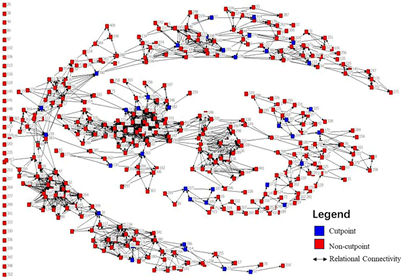 |
| Classification of Villages | The Number of Traditional Villages | The Number of Villages for Tangent Points | Proportion |
|---|---|---|---|
| Traditional Farming Type | 306 | 27 | 8.82% |
| Science Education-Oriented Type | 22 | 3 | 13.64% |
| Boutique Homestay Type | 16 | 3 | 18.75% |
| Ecological Landscape Type | 39 | 5 | 12.82% |
| Specialty Product Type | 32 | 1 | 3.13% |
| First Indicators | Secondary Indicators | Evaluation Rating A (9 Scores) | Evaluation Level B (6 Scores) | Evaluation Level C (3 Scores) | Weights | Weights |
|---|---|---|---|---|---|---|
| Industrial Development Foundation, | Primary industrial base | Modernization of agriculture, with special characteristics and on a large scale | Traditional agriculture predominates, with a small amount of modern agriculture beginning to develop | Agricultural development model as traditional agriculture | 0.16 | 0.65 |
| Status of tourism development | The village has developed the tourism industry for more than two years, and the volume of tourism is more than 60,000 trips | Development of tourism industry in the village for more than one year, and the volume of tourism is more than 40,000 visitors | The tourism industry is in a poorly developed or underdeveloped state. | 0.49 | ||
| Human Settlements Foundation | service | Habitat improvement projects such as water supply and sewage treatment have been completed, and there are comprehensive management, education and medical facilities | Habitat upgrading works such as water supply, sewage treatment, etc., partially completed, and some management, education and medical facilities available | Average habitat and amenities | 0.05 | 0.08 |
| environment | The overall style of the village continues to be intact, with no mixed modern-style buildings and good ecological environment | The overall landscape of the village continues to be relatively intact, partially mixed with modern-style buildings, and the ecological environment is relatively good | The continuation of the village landscape is basically intact, with more mixed buildings and an average ecological environment | 0.02 | ||
| Architectural quality | Traditional buildings are well preserved as a whole, with a vacancy rate of less than 10 per cent | Overall preservation of traditional buildings is average, with a vacancy rate of less than 20% in the hollow core | Overall preservation of traditional buildings is poor, and the rate of hollowing out and idling is higher than 20 percent | 0.02 | ||
| Resource Development Foundation | Model evaluations | National titles such as national-level historical and cultural villages, national-level intangible cultural heritage or national-level characteristic villages | Provincial titles such as Provincial Famous Historical and Cultural Village, Provincial Intangible Cultural Heritage or Provincial Characteristic Villages | (sth. or sb) else | 0.08 | 0.27 |
| accessible via transportation | Within half an hour’s drive of a city or a well-connected major attraction | Within half an hour to an hour’s drive of a city or a well-connected major attraction | More than 1 h’s drive from the city or a well-connected major attraction | 0.14 | ||
| Resource elements | Two or more state-protected units or three or more provincial-protected units, the village is rich in natural and human elements (ancient trees, ancient bridges, water systems, courtyards, etc.) and rich in cultural heritage | One or more national conservation units or two or more provincial conservation units, more natural and human elements (ancient trees, ancient bridges, water systems, courtyards, etc.) in the village, more cultural heritage | The village has more natural and human elements (old trees, old bridges, water systems, courtyards, etc.) and has cultural heritage | 0.04 |
| Stage Value of Development Potential | Classification of Villages | Number of Traditional Villages | The Proportion of Village Types with Potential for Development Relative to the Total Number of Villages of That Type | Number of Villages for Development Potential Values | Proportion | Total Sum of K-Values | Average of K-Values | Total Sum of Degree Centrality Potential | Average of Degree Centrality Potential |
|---|---|---|---|---|---|---|---|---|---|
| 1.439700–1.872900 | Traditional Farming Type | 180 | 58.36% | 225 | 54.22% | 601.00 | 2.67 | 880.00 | 3.91 |
| Science Education-Oriented Type | 11 | 52.38% | |||||||
| Boutique Homestay Type | 2 | 13.33% | |||||||
| Ecological Landscape Type | 16 | 40.00% | |||||||
| Specialty Product Type | 16 | 50.00% | |||||||
| 1.872900–2.848800 | Traditional Farming Type | 110 | 35.83% | 142 | 34.22% | 800.00 | 5.63 | 1165.00 | 8.20 |
| Science Education-Oriented Type | 6 | 28.57% | |||||||
| Boutique Homestay Type | 4 | 26.67% | |||||||
| Ecological Landscape Type | 12 | 30.00% | |||||||
| Specialty Product Type | 10 | 31.25% | |||||||
| 1.872900–2.848800 | Traditional Farming Type | 17 | 5.54% | 48 | 11.57% | 327.00 | 6.81 | 509.00 | 10.60 |
| Science Education-Oriented Type | 4 | 19.05% | |||||||
| Boutique Homestay Type | 9 | 60.00% | |||||||
| Ecological Landscape Type | 12 | 30.00% | |||||||
| Specialty Product Type | 6 | 18.75% |
Disclaimer/Publisher’s Note: The statements, opinions and data contained in all publications are solely those of the individual author(s) and contributor(s) and not of MDPI and/or the editor(s). MDPI and/or the editor(s) disclaim responsibility for any injury to people or property resulting from any ideas, methods, instructions or products referred to in the content. |
© 2025 by the authors. Licensee MDPI, Basel, Switzerland. This article is an open access article distributed under the terms and conditions of the Creative Commons Attribution (CC BY) license (https://creativecommons.org/licenses/by/4.0/).
Share and Cite
Fan, J.; Zheng, B.; Yuan, H.; Zhang, B.; Zhang, P. Spatial Connectivity and Development Potential of Traditional Villages in Clustered Areas: A Case Study of Qiandongnan Prefecture. Land 2025, 14, 1929. https://doi.org/10.3390/land14101929
Fan J, Zheng B, Yuan H, Zhang B, Zhang P. Spatial Connectivity and Development Potential of Traditional Villages in Clustered Areas: A Case Study of Qiandongnan Prefecture. Land. 2025; 14(10):1929. https://doi.org/10.3390/land14101929
Chicago/Turabian StyleFan, Jinyu, Bohong Zheng, Huayan Yuan, Boyang Zhang, and Piao Zhang. 2025. "Spatial Connectivity and Development Potential of Traditional Villages in Clustered Areas: A Case Study of Qiandongnan Prefecture" Land 14, no. 10: 1929. https://doi.org/10.3390/land14101929
APA StyleFan, J., Zheng, B., Yuan, H., Zhang, B., & Zhang, P. (2025). Spatial Connectivity and Development Potential of Traditional Villages in Clustered Areas: A Case Study of Qiandongnan Prefecture. Land, 14(10), 1929. https://doi.org/10.3390/land14101929






